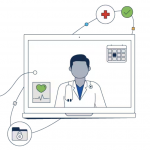As part of our National Health IT Week series, today we are focusing on advancing public health and population health. We will look at critical efforts to overcome the problems that lead to poor health outcomes. Addressing pain points that impact the patient, clinician, IT, and administration within a healthcare organization are key to overcoming these challenges.
Mercy, one of healthcare’s “most-wired” organizations, has taken steps to integrate technology into its efforts to personalize the patient experience, streamline clinician experience, and optimize operations – all while facilitating security and compliance. By addressing these pain points, they have been better able to have a positive impact on the patients they care for and the communities they serve.
Explore some of the efforts the Mercy has undertaken:
Personalizing the patient experience
Seeking medical care can be overwhelming and confusing. With in-person and virtual services, it’s possible to deliver 24-hour care that’s easy to access and navigate, increasing patient and caregiver engagement and satisfaction.
Mercy wanted the experience a patient has calling to schedule an appointment to be just like walking into the doctor’s office. Time matters in healthcare. And every time a patient who is in pain or anxious about a loved one is put on hold or they hear a pause, could feel like a lifetime. To take on this challenge of personalizing care, Mercy deployed Nurse on Call, supported by Cisco Contact Center technology.
“When a patient calls Nurse on Call, the Cisco technology recognizes the phone number of the patient, which then automatically opens the correct electronic health record. We needed this technology to help us find their record faster. After the implementation, we saved about 43 seconds per call in locating the patient in the electronic health record system. This technology has allowed us 6 more hours in our day to really get that experience right.”
—Cindy Rydberg, Executive Director, Nurse on Call, Mercy Virtual
Streamlining the clinical experience
Technology should help staff provide care, not create barriers. From preventive to specialized care, solutions that help clinicians communicate and stay connected boost effectiveness and efficiency. As a result, this improves care team coordination and collaboration.
At Mercy, inefficient communication tools and services were causing staff frustration. Through enhanced text, voice, and video technology, they were able to create a more collaborative environment to improve communications and productivity among co-workers and care teams.
“It really changed the way we deliver care. High availability and ease of use really translates into an empowered caregiver that’s able to focus more on the patient and able to spend more time with the patient and not worry about the friction of that technology.”
—Scott Richert, Chief Technology Officer, Mercy Technology Services
Facilitating security and compliance
Healthcare is more connected than ever. As a result, there are new opportunities but also new vulnerabilities. As cybersecurity threats grow increasingly sophisticated and frequent, organizations need to find innovative ways to provide IT security and meet regulatory requirements.
Protecting connected medical devices and fending off ransomware attacks can be daunting. For Mercy, this has meant a lot of blocking and tackling. Finding a balance between protecting legacy technology that was not designed with security in mind, and the organization’s voracious appetite for innovation has been key.
Watch the “How Mercy is Prioritizing Security and Driving Innovation” webinar
“What we don’t want to do is create tomorrow’s problem’s today. So, we work very closely with Scott’s organization [Chief Technology Officer]. When we bring in new technology, we evaluate it, and we say, ‘okay this is great.’ We don’t say, ‘no.’ We say, “This is great. This brings a lot of value to the organization. Now, let’s make sure that we take the proper steps in deploying that [technology] so we’ve secured the tool.’ That value can quickly evaporate if it is not properly permitted with the right security tools in place.”
—Dan Henke, Chief Information Security Officer, Mercy Technology Services
Optimizing clinical, business, and IT operations
On the road to a better bottom line, IT should serve as a facilitator, not a bottleneck. Transforming healthcare operations can help increase efficiency and access to information, reduce waste, keep costs down, boost staff productivity, and automate your network.
Mercy took on standardizing on Epic EMR software deployed from a single data center to support all its hospitals and physician practices. As a result, Mercy’s IT organization, Mercy Technology Services, soon became experts in deploying and managing Epic. They were able to become an Epic service provider—delivering high-quality EMR services to support other hospitals and health systems.
“It’s not good enough to have data that was two days old or three days old or a month old. It has to be real time. And to be able to do that, you have to have the infrastructure that can provide the performance to deliver on that goal.”
—Gil Hoffman, Chief Information Officer (retired), Mercy
–
Check back for the rest of our National Health IT Week blog series to learn more about IT strategies that can help:
- Expand access to broadband and telehealth
- Address social determinants of health
- Accelerate workforce development
- Modernize public health infrastructure


CONNECT WITH US